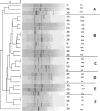Molecular typing and virulence analysis of multidrug resistant Klebsiella pneumoniae clinical isolates recovered from Egyptian hospitals
- PMID: 28004732
- PMCID: PMC5177892
- DOI: 10.1038/srep38929
Molecular typing and virulence analysis of multidrug resistant Klebsiella pneumoniae clinical isolates recovered from Egyptian hospitals
Abstract
Klebsiella pneumonia infection rates have increased dramatically. Molecular typing and virulence analysis are powerful tools that can shed light on Klebsiella pneumonia infections. Whereas 77.7% (28/36) of clinical isolates indicated multidrug resistant (MDR) patterns, 50% (18/36) indicated carpabenem resistance. Gene prevalence for the AcrAB efflux pump (82.14%) was more than that of the mdtK efflux pump (32.14%) in the MDR isolates. FimH-1 and mrkD genes were prevalent in wound and blood isolates. FimH-1 gene was prevalent in sputum while mrkD gene was prevalent in urine. Serum resistance associated with outer membrane protein coding gene (traT) was found in all blood isolates. IucC, entB, and Irp-1 were detected in 32.14%, 78.5% and 10.7% of MDR isolates, respectively. We used two Polymerase Chain Reaction (PCR) analyses: Enterobacterial Repetitive Intergenic Consensus (ERIC) and Random Amplified Polymorphic DNA (RAPD). ERIC-PCR revealed 21 and RAPD-PCR revealed 18 distinct patterns of isolates with similarity ≥80%. ERIC genotyping significantly correlated with resistance patterns and virulence determinants. RAPD genotyping significantly correlated with resistance patterns but not with virulence determinants. Both RAPD and ERIC genotyping methods had no correlation with the capsule types. These findings can help up better predict MDR Klebsiella pneumoniae outbreaks associated with specific genotyping patterns.
Figures


Similar articles
-
A Study of the Virulence Traits of Carbapenem-Resistant Klebsiella pneumoniae Isolates in a Galleria mellonella Model.Microb Drug Resist. 2019 Sep;25(7):1063-1071. doi: 10.1089/mdr.2018.0270. Epub 2019 Apr 27. Microb Drug Resist. 2019. PMID: 31033413
-
New sequence type in multidrug-resistant Klebsiella pneumoniae harboring the blaNDM-1-encoding gene in Brazil.Int J Infect Dis. 2019 Feb;79:101-103. doi: 10.1016/j.ijid.2018.11.012. Epub 2018 Nov 26. Int J Infect Dis. 2019. PMID: 30496852
-
Presence of fimH, mrkD, and irp2 virulence genes in KPC-2-producing Klebsiella pneumoniae isolates in Recife-PE, Brazil.Curr Microbiol. 2014 Dec;69(6):824-31. doi: 10.1007/s00284-014-0662-0. Epub 2014 Aug 2. Curr Microbiol. 2014. PMID: 25085544
-
Antimicrobial resistance pattern, virulence determinants and molecular analysis of carbapenem-resistant Klebsiella pneumoniae isolated from clinical samples in Iran.FEMS Microbiol Lett. 2022 Nov 9;369(1):fnac100. doi: 10.1093/femsle/fnac100. FEMS Microbiol Lett. 2022. PMID: 36269301
-
Virulence genes, efflux pumps, and molecular typing of Klebsiella pneumoniae isolates from North Iran.AMB Express. 2025 Mar 5;15(1):36. doi: 10.1186/s13568-025-01845-1. AMB Express. 2025. PMID: 40045145 Free PMC article.
Cited by
-
Antibiotyping, RAPD- and ERIC-PCR fingerprinting of Klebsiella pneumoniae clinical isolates at a tertiary reference hospital in Denpasar, Bali, Indonesia.Iran J Microbiol. 2024 Jun;16(3):306-313. doi: 10.18502/ijm.v16i3.15761. Iran J Microbiol. 2024. PMID: 39005601 Free PMC article.
-
An Outbreak of Carbapenem-Resistant and Hypervirulent Klebsiella pneumoniae in an Intensive Care Unit of a Major Teaching Hospital in Wenzhou, China.Front Public Health. 2019 Aug 19;7:229. doi: 10.3389/fpubh.2019.00229. eCollection 2019. Front Public Health. 2019. PMID: 31552210 Free PMC article.
-
Genotypic Characterization of Carbapenem-Resistant Klebsiella pneumoniae Isolated from an Egyptian University Hospital.Pathogens. 2023 Jan 11;12(1):121. doi: 10.3390/pathogens12010121. Pathogens. 2023. PMID: 36678469 Free PMC article.
-
Genotypic validation of extended-spectrum β-lactamase and virulence factors in multidrug resistance Klebsiella pneumoniae in an Indian hospital.Pathog Glob Health. 2019 Oct;113(7):315-321. doi: 10.1080/20477724.2019.1705020. Epub 2019 Dec 22. Pathog Glob Health. 2019. PMID: 31865867 Free PMC article.
-
High Prevalence of Multidrug-Resistant Klebsiella pneumoniae Harboring Several Virulence and β-Lactamase Encoding Genes in a Brazilian Intensive Care Unit.Front Microbiol. 2019 Jan 22;9:3198. doi: 10.3389/fmicb.2018.03198. eCollection 2018. Front Microbiol. 2019. PMID: 30723463 Free PMC article.
References
-
- Brisse S. & Verhoef J. Phylogenetic diversity of Klebsiella pneumoniae and Klebsiella oxytoca clinical isolates revealed by randomly amplified polymorphic DNA, gyrA and parC genes sequencing and automated ribotyping. Int J Syst Evol Microbiol 51, 915–924, doi: 10.1099/00207713-51-3-915 (2001). - DOI - PubMed
-
- Daef E. A. & Elsherbiny N. M. Clinical and Microbiological Profile of Nosocomial Infections in Adult Intensive Care Units at Assiut University Hospitals, Egypt. Journal of American Science 8, 1239–1250 (2012).
Publication types
MeSH terms
Substances
LinkOut - more resources
Full Text Sources
Other Literature Sources
Medical

